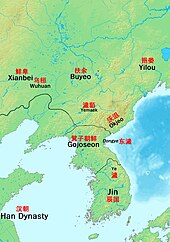Jin-guk
| Korean spelling | |
|---|---|
| Korean alphabet : | 진국 |
| Hanja : | 辰 國 |
| Revised Romanization : | Jin-guk |
| McCune-Reischauer : | Chin'guk |
Jin , also called Jin-guk ("Jin Empire"), was a Bronze Age state in East Asia , which was believed to have existed between the 3rd and 2nd centuries BC. It covered parts of the southern Korean Peninsula and bordered Go-Joseon in the north . Its capital was south of the Han Gang .
Little is known about the Jin Kingdom. It merged into the Samhan State Union , whose members saw themselves as Jin's heirs.
history
|
History of Korea to the 10th Century |
|---|
| Prehistoric Korea |
|
| Antiquity |
| Proto-three realms |
| Time of the Three Kingdoms |
| Northern and Southern states |
|
| Later three realms |
|
The Jin Kingdom appears in various Chinese scriptures, including a. the Sanguo Zhi , in which the reception of ambassadors at the court of the Han dynasty is mentioned. Possibly the Gaeguk or Gaemaguk ( Chinese 蓋 馬 馬 , "Empire of the Armored Horses") mentioned in Chinese sources is Jin.
It is unclear to what extent Jin was actually a cohesive, organized state. It is also possible that Jin was simply a union of smaller tribes and city-states. However, since the state sent ambassadors to the Han dynasty, one can at least assume a certain degree of central violence.
It is reported that King Jun 194 BC. He is said to have fled from Go-Joseon to Jin after he was overthrown by Wiman .
Jin was the forerunner of the Samhan State Union , whose member Jinhan continued to bear the name. The leaders of Manhan also referred to themselves as "kings of Jin" to express their claim to all of Samhan.
Culture
Archaeologically, Jin is mostly classified in the Korean bronze dagger culture, which began at the end of the first millennium BC. BC originated. Most of the finds were made in the southwest of the South Korean provinces of Chungcheong and Jeolla , which allows conclusions to be drawn about the geographic location of Jin.
